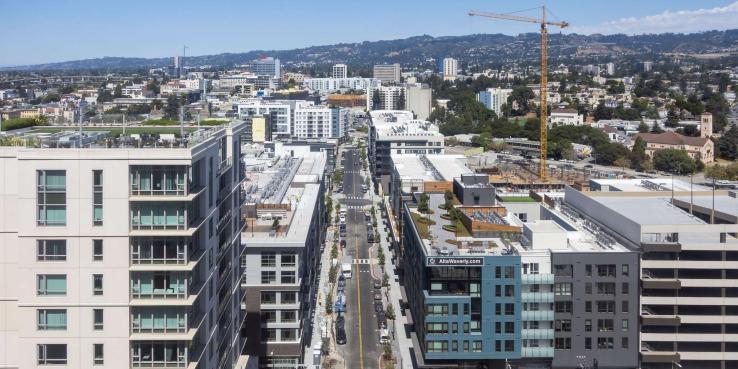With the long run up in Oakland’s rental prices slowing down, if only temporarily, the city is becoming something of a renter’s market. Production of new housing — one of the “three Ps” that the Oakland Housing Action Plan and the CASA Compact say are needed to stop residential displacement — is the factor responsible for this shift. While there is no doubt that displacement cannot be fought without the other two Ps — housing preservation and tenant/homeowner protections — there is also no doubt that the Bay Area cannot get out of its current housing deficit without building more housing.
What is happening now in Oakland bears that out.
Though rents remain astronomical (an average of $2,636 for a one bedroom and $3,423 for a two bedroom), the annual rent increase has slowed dramatically to 1.9%. This is in stark contrast to 2014–2018, when the average rent for all units increased 35%. Another stark contrast is in the amount of housing built in Oakland over that same period: Fewer than 1,000 units were built each year between 2009 and 2017; this year, 6,800 will be completed. In some neighborhoods, Uptown being one, developers are currently offering between four and six weeks of free rent to lure prospective tenants in a market now awash with supply. With more units coming on the market soon — in Uptown, downtown, Brooklyn Basin, at MacArthur BART and in West Oakland — this effect will likely continue, at least until these units fill up.
Other changes are making the neighborhood that used to be Oakland’s Auto Row more attractive to prospective tenants and more of a draw for the whole region. Target will be opening a store at 27th and Broadway, and Bi-Rite at West Grand and Broadway. With dozens of new businesses and thousands of new employees coming to Uptown Station and elsewhere, hotels are under construction for the first time in nearly 20 years: The Moxy is set to open in 2021 at West Grand and Telegraph, and another hotel will open in 2021 at 24th and Broadway.
From the perspective of renters who can afford Oakland’s market-rate rents, this is all welcome news. But the benefits are not limited solely to them. Dozens of new apartment and condo developments will pay impact fees, which will help fund new affordable housing for lower-income residents. Hundreds of new revenue-producing hotel rooms and dozens of new businesses will generate tax revenue to support public services across the city. And thousands of new residents and visitors will bring life to a formerly overlooked part of town.
More and more research is demonstrating that construction of new market-rate housing has benefits for those who already live in the neighborhood. A recent study published by the National Community Reinvestment Coalition found that the investment in and revitalization of neighborhoods doesn’t have to involuntarily displace the people who have lived there for years. According to the study, whether or not displacement follows development comes down to one of the other Ps mentioned earlier: protection. Of the 1,049 census tracts across the country in which median home value, educational attainment of residents and median income increased (the three measures of gentrification used in the study) only 22% of them experienced involuntary displacement. There were two reason for the difference:
1. Neighborhoods that had an influx of new residents but kept the same number of housing units experienced displacement, while those in which the supply of new housing increased to match the demand did not.
2. Neighborhoods where the long-term residents owned their homes rather than renting were also able to avoid involuntary displacement, and the displacement they did experience was voluntary, caused by long-term homeowners selling their homes for considerable profit. Those homeowners who chose not to sell were able to stay put and reap the benefits of improvements in their neighborhood.
Investment in neighborhoods and involuntary displacement are related phenomena, but they are distinct. The market-rate units opening in Oakland now are more expensive than most people can afford, but the mere fact that they are opening is a necessary — though not sufficient — step along the path to slowing displacement and making the city affordable again. One of the pieces — increased housing production — is now falling into place. But we still need to work on another: increasing the rates of home ownership among lower-income populations so they can stay in Oakland and benefit from investments in their neighborhoods. We also need to make sure that the supply of housing continues to keep pace with, and maybe even exceed, demand. Otherwise rents will start shooting up again.
